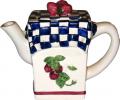Bubble tea (or Boba tea) is the generic name for any tea that contains tapioca pearl. Before consumption, the tea needs to be shaken to mix all the ingredients, and it would form bubbles - hence the name Bubble Tea!
A versatile drink, bubble tea comes in many variations of flavor and color. Due to its versatility, it is fast becoming one of the most popular tea drinks in the world.
Other names for bubble tea include black pearl tea, boba ice tea, boba drink, boba, pearl tea drink, pear shake, pearl milk tea, tapioca ball drink, QQ and many others.
Drinking bubble tea
Bubble tea is normally served cold and in a clear plastic container, with the tapioca pearl resting on the bottom.
The tea itself is milk tea. Flavoring, crushed ice and fresh fruit are added to the tea, creating a variety of different colors. Fruit juice and coconut can also be added, to create different tastes. The tea is drunk through a large straw - the straw is needed to suck up the large pearls.
The variety of flavors and colors is completely up to your imagination - There is even multi-colored bubble tea! Usually bubble tea comes in pastel colors, such as yellow, orange or green.
Making bubble tea
When making bubble tea, the tea mixture is placed in the container first, followed by the flavoring, fresh fruit, crushed ice and finally the tapioca pearl. The container is sealed over with plastic, and the contents firmly shaken. The lid is finally pierced by a large straw.
Tapioca pearls are black, but can also be white or translucent. The black tapioca pearls are made from sweet potatoes, tapioca starch - made from tapioca root - and brown sugar. The white and translucent pearls are made from caramel, starch and chamomile root extract. Tapioca pearls have a soft, chewy gum-like texture - much like gummy lollies.
History of bubble tea
Bubble tea originated in Taiwan. In the early 1980s, small tea stands would compete with each other for the best bubble tea, while elementary school children would look forward to buying a drink after a long day at school. One enterprising owner started adding different fruit flavoring to her tea. When this became popular, other tea stall owners followed suit.
In 1983, Liu Han-Chieh introduced tapioca pearls to Taiwan, and it became popular to add the pearls to a drink. The tapioca pearls were usually served in cold tea, along with some flavoring. After the various ingredients - tea, flavoring and tapioca pearls - were placed together, they were shaken well. The bubble from the shaking and the bubble-like appearance of the tapioca pearl gave bubble tea its name.
The phenomenon quickly spread throughout Taiwan, then to other countries. One company has over 450 shops in the Philippines alone!
Bubble tea can be made at home, although it is easier to buy direct from a store. Preparing the tapioca pearls can be labor intensive, and the tapioca pearl must be used immediately to maintain its gum-like texture.
